932 海外项目安全管理:梯子--英文版 Ladders
- 格式:doc
- 大小:50.50 KB
- 文档页数:7
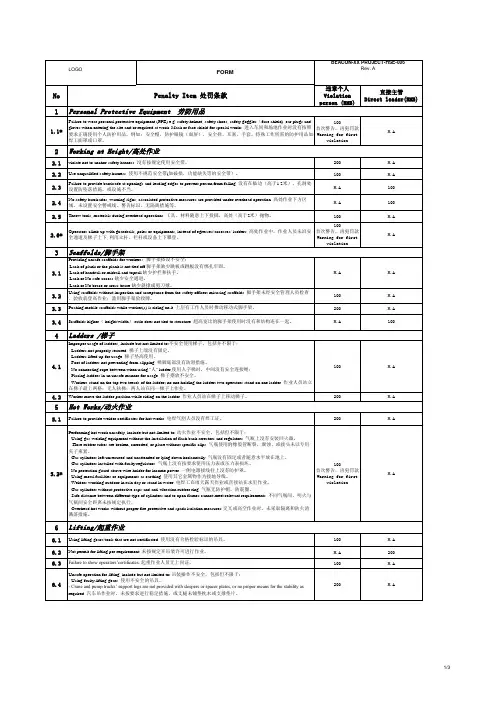
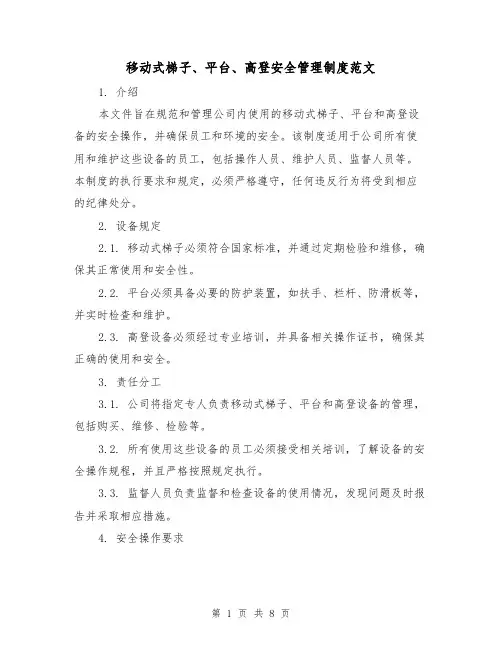
移动式梯子、平台、高登安全管理制度范文1. 介绍本文件旨在规范和管理公司内使用的移动式梯子、平台和高登设备的安全操作,并确保员工和环境的安全。
该制度适用于公司所有使用和维护这些设备的员工,包括操作人员、维护人员、监督人员等。
本制度的执行要求和规定,必须严格遵守,任何违反行为将受到相应的纪律处分。
2. 设备规定2.1. 移动式梯子必须符合国家标准,并通过定期检验和维修,确保其正常使用和安全性。
2.2. 平台必须具备必要的防护装置,如扶手、栏杆、防滑板等,并实时检查和维护。
2.3. 高登设备必须经过专业培训,并具备相关操作证书,确保其正确的使用和安全。
3. 责任分工3.1. 公司将指定专人负责移动式梯子、平台和高登设备的管理,包括购买、维修、检验等。
3.2. 所有使用这些设备的员工必须接受相关培训,了解设备的安全操作规程,并且严格按照规定执行。
3.3. 监督人员负责监督和检查设备的使用情况,发现问题及时报告并采取相应措施。
4. 安全操作要求4.1. 在使用移动式梯子、平台和高登设备之前,必须检查其是否完好无损,并确保没有松动或损坏的部件。
4.2. 在使用过程中,应稳定设备底座,确保设备不会晃动或倾覆。
4.3. 在使用过程中,禁止站在不稳定的位置上,如移动部件、扶手等。
4.4. 使用设备时,应佩戴个人防护装备,如安全帽、护目镜、防滑鞋等。
4.5. 在使用过程中,必须注意周围环境,避免碰撞、触电等意外风险。
4.6. 不允许在设备上进行非工作相关的活动,如玩耍、吃饭等。
5. 维护和检查5.1. 设备的维护和检查由专人负责,包括定期的检测、维修和更换损坏的部件。
5.2. 员工在使用设备之前,必须检查设备是否经过维护和检修,并在情况不符合要求的情况下停止使用,并向上级报告。
5.3. 长时间不使用的设备,必须进行彻底检查和维修,确保安全使用。
6. 紧急情况处理6.1. 在发生设备故障、意外事故或紧急情况时,员工应立即停止使用设备,并向上级报告情况。
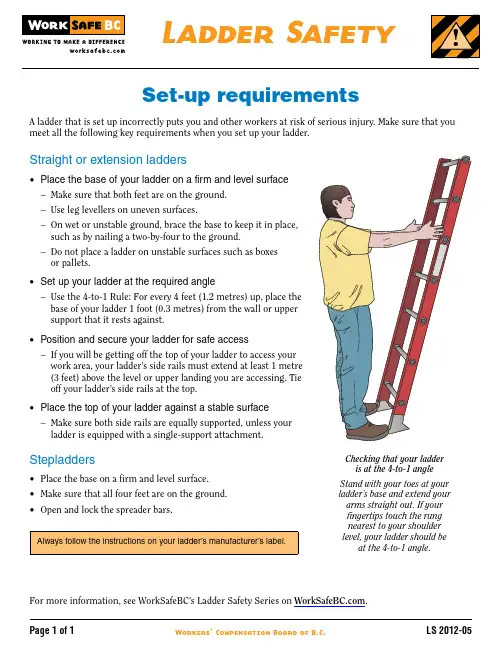
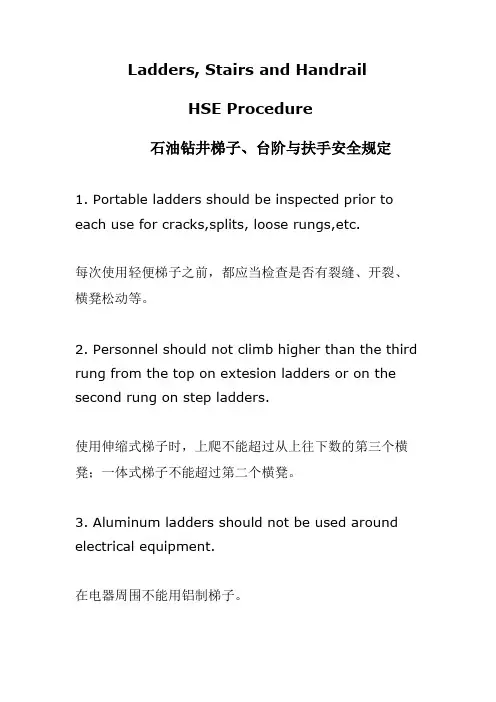
Ladders, Stairs and HandrailHSE Procedure石油钻井梯子、台阶与扶手安全规定1. Portable ladders should be inspected prior to each use for cracks,splits, loose rungs,etc.每次使用轻便梯子之前,都应当检查是否有裂缝、开裂、横凳松动等。
2. Personnel should not climb higher than the third rung from the top on extesion ladders or on the second rung on step ladders.使用伸缩式梯子时,上爬不能超过从上往下数的第三个横凳;一体式梯子不能超过第二个横凳。
3. Aluminum ladders should not be used around electrical equipment.在电器周围不能用铝制梯子。
4. Ladders should not be used in a horizontal position as a scaffold.不能把梯子放平当脚手架。
5. Portable metal or aluminium ladders should be equipped with non-skid feet.金属或铝制的轻便梯子应当装防滑凳。
6. Wooden portable ladders should not be pained.木制的轻便梯子不应当喷漆。
7. When in use, portable ladders should be secured at the top. If not, it should be held by another person.使用轻便梯子时,要把顶部拴住,否则,就由另一个人扶着。
8. Personnel should not use boxes, chairs, sawhorses, tables, etc., to improvise a ladder.不能把箱子、椅子、锯木架、桌子等,改成临时梯子。
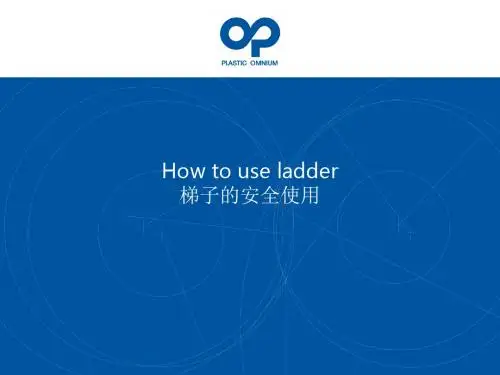
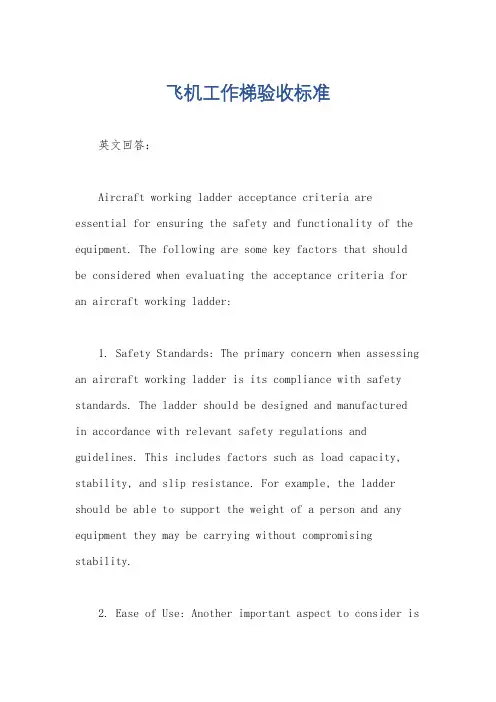
飞机工作梯验收标准英文回答:Aircraft working ladder acceptance criteria are essential for ensuring the safety and functionality of the equipment. The following are some key factors that should be considered when evaluating the acceptance criteria for an aircraft working ladder:1. Safety Standards: The primary concern when assessing an aircraft working ladder is its compliance with safety standards. The ladder should be designed and manufacturedin accordance with relevant safety regulations and guidelines. This includes factors such as load capacity, stability, and slip resistance. For example, the ladder should be able to support the weight of a person and any equipment they may be carrying without compromising stability.2. Ease of Use: Another important aspect to consider isthe ease of use of the ladder. The ladder should be designed in a way that allows for easy and safe access to the aircraft. This includes features such as handrails,non-slip steps, and a stable base. Additionally, the ladder should be adjustable to accommodate different aircraft heights and configurations. For instance, it should be able to reach the door of a small regional aircraft as well as the higher doors of a wide-body aircraft.3. Durability and Maintenance: The durability of the ladder is crucial for long-term use. It should be made of high-quality materials that can withstand the harsh conditions of the aviation environment. The ladder should also be designed to be easily maintainable, with replaceable parts and clear instructions for repairs. This ensures that the ladder remains in good working condition and minimizes the risk of accidents due to equipment failure.4. Ergonomics: The ladder should be designed with the comfort and safety of the user in mind. This includes features such as ergonomic handholds and steps that are ata comfortable height and angle. The ladder should also be lightweight and easy to maneuver. For example, the ladder could have wheels or a handle for easy transportation.5. Compliance with Industry Standards: It is importantto ensure that the ladder meets industry standards and guidelines. This includes standards set by organizations such as the International Civil Aviation Organization (ICAO) and the Occupational Safety and Health Administration (OSHA). Compliance with these standards ensures that the ladder is suitable for use in the aviation industry and meets the necessary safety requirements.中文回答:飞机工作梯验收标准对于确保设备的安全性和功能性至关重要。
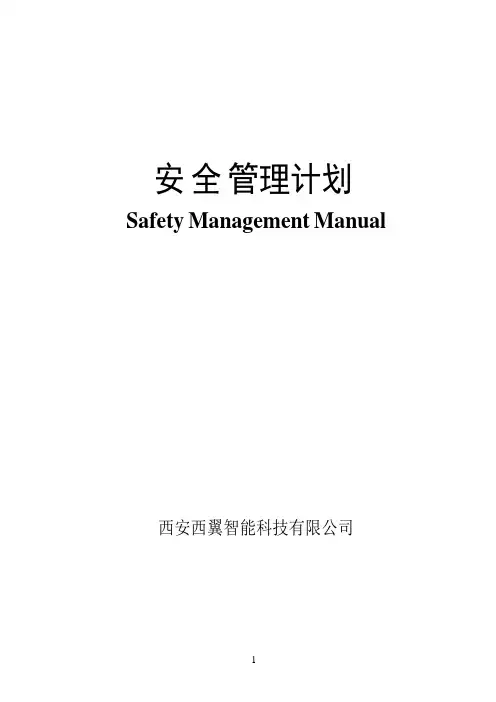
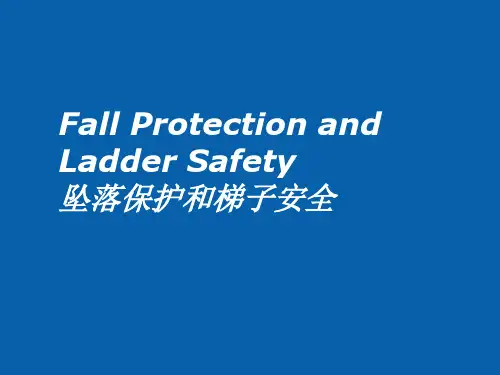
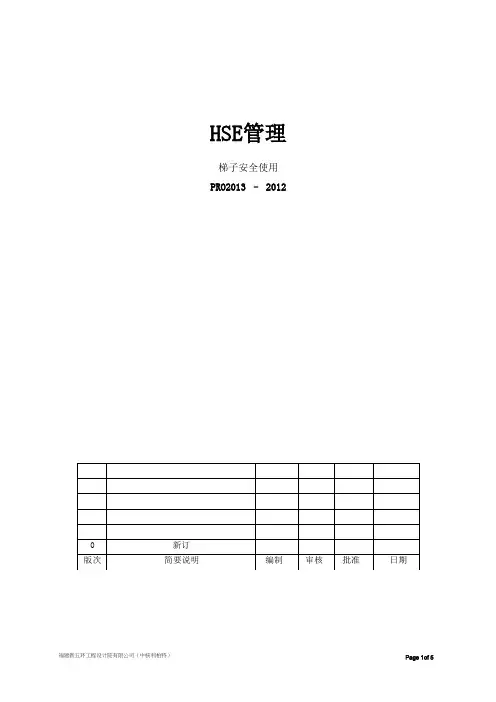
HSE管理梯子安全使用PRO2013 – 2012目次1.0PURPOSE目的 (3)2.0HANDLING AND USE PRACTICES操作和使用规程 (3)3.0LADDER INSPECTION梯子检查 (5)4.0STORING AND TRANSPORTING 存储和运输 (6)5.0ATTACHMENT附件 (6)Attachment A:Ladder Inspection Guidelines 梯子检查指南... 错误!未定义书签。
1.0PURPOSE目的The purpose of this procedure is to ensure that ladders used on the Project are safe to use and proper techniques are used in handling and using them.本程序的建立,其目的是为了确保在项目上所使用的梯子能够得到安全、正确使用以及相应技术上的支持。
2.0HANDLING AND USE PRACTICES操作和使用规程2.1 It is the responsibility of the user to thoroughly inspect the ladder prior to use. Items to beinspected include rails, connections, and hardware. Loose connections, sharp edges, burrs or worn parts shall be noted. If defects are found, the ladder will be tagged: “DO NOT USE”and taken out of service. The user who finds the defective ladder is responsible for tagging it “DANGER - DO NOT USE” and arranging for its removal from site. Use the attachedladder inspection guidelines for reference. (ATTACHMENT A)使用者应负责在使用梯子前进行检查。
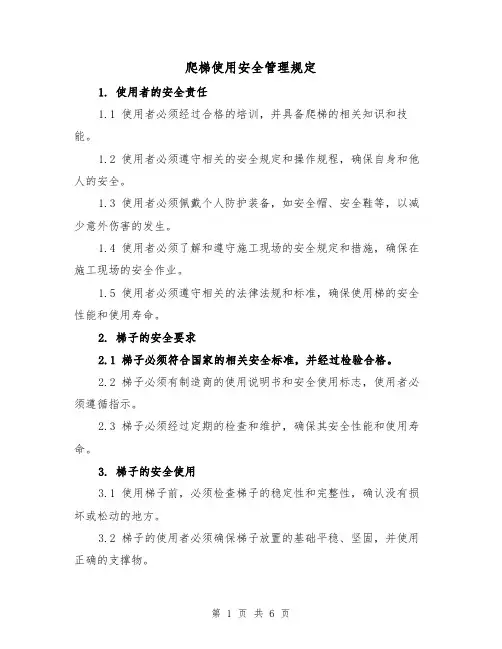
爬梯使用安全管理规定1. 使用者的安全责任1.1 使用者必须经过合格的培训,并具备爬梯的相关知识和技能。
1.2 使用者必须遵守相关的安全规定和操作规程,确保自身和他人的安全。
1.3 使用者必须佩戴个人防护装备,如安全帽、安全鞋等,以减少意外伤害的发生。
1.4 使用者必须了解和遵守施工现场的安全规定和措施,确保在施工现场的安全作业。
1.5 使用者必须遵守相关的法律法规和标准,确保使用梯的安全性能和使用寿命。
2. 梯子的安全要求2.1 梯子必须符合国家的相关安全标准,并经过检验合格。
2.2 梯子必须有制造商的使用说明书和安全使用标志,使用者必须遵循指示。
2.3 梯子必须经过定期的检查和维护,确保其安全性能和使用寿命。
3. 梯子的安全使用3.1 使用梯子前,必须检查梯子的稳定性和完整性,确认没有损坏或松动的地方。
3.2 梯子的使用者必须确保梯子放置的基础平稳、坚固,并使用正确的支撑物。
3.3 梯子的使用者必须确保梯子的梯梁、脚脱和吊杆的连接稳固,不能有松动或缺失。
3.4 梯子的使用者必须保持梯子的干燥和清洁,防止滑倒和摔伤的发生。
3.5 在使用梯子时,必须确保梯子与电线、管道等物品保持足够的距离,避免触电或挤压等危险。
3.6 在使用梯子时,除了使用者本人外,其他人必须远离梯子,以防止发生意外伤害。
3.7 梯子不得超过其标称负荷或最大使用负荷,以免导致梯子的损坏或使用者的伤害。
4. 梯子的储存和运输4.1 梯子在储存时,必须放在干燥、通风的地方,并远离火源和腐蚀性物质。
4.2 梯子的运输必须使用专门的车辆和工具,确保梯子的稳定和安全。
4.3 在运输过程中,梯子必须固定好,避免滑动和倾倒的危险。
5. 事故和应急措施5.1 发生梯子使用事故时,使用者必须立即停止使用梯子,并采取相应的应急措施,保护自身和他人的安全。
5.2 发生梯子使用事故时,必须及时报告相关部门,进行事故调查和处理,并采取措施防止再次发生类似事故。
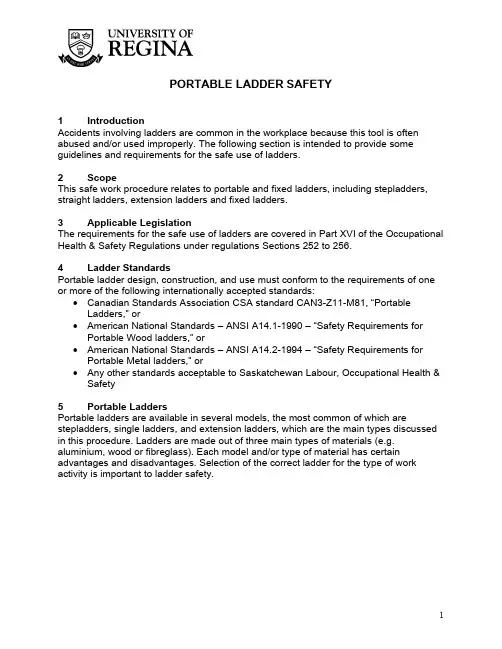
PORTABLE LADDER SAFETY1 IntroductionAccidents involving ladders are common in the workplace because this tool is often abused and/or used improperly. The following section is intended to provide some guidelines and requirements for the safe use of ladders.2 ScopeThis safe work procedure relates to portable and fixed ladders, including stepladders, straight ladders, extension ladders and fixed ladders.Legislation3 ApplicableThe requirements for the safe use of ladders are covered in Part XVI of the Occupational Health & Safety Regulations under regulations Sections 252 to 256.Standards4 LadderPortable ladder design, construction, and use must conform to the requirements of one or more of the following internationally accepted standards:• Canadian Standards Association CSA standard CAN3-Z11-M81, “Portable Ladders,” or• American National Standards – ANSI A14.1-1990 – “Safety Requirements for Portable Wood ladders,” or• American National Standards – ANSI A14.2-1994 – “Safety Requirements for Portable Metal ladders,” or• Any other standards acceptable to Saskatchewan Labour, Occupational Health & Safety5 PortableLaddersPortable ladders are available in several models, the most common of which are stepladders, single ladders, and extension ladders, which are the main types discussed in this procedure. Ladders are made out of three main types of materials (e.g. aluminium, wood or fibreglass). Each model and/or type of material has certain advantages and disadvantages. Selection of the correct ladder for the type of work activity is important to ladder safety.PORTABLE LADDER SAFETYLadders5.1 SingleSingle ladders consist of two side rails and evenly spaced rungs. They do not have any moving parts, are non-self-supporting and are not adjustable in length. They are limited to a single section. Their size is defined by the overall length of the side rail, excluding any foot or end caps. Their rung width is at least 300 mm (12 in) for ladders up to 3 m (10ft) in length. Rung width will increase 1 mm for each additional 100 mm of length (0.125 in/ft). The maximum length of single ladders must not exceed:Type 1 – Heavy duty – 9 m (30 ft)Type 2 – Medium duty – 7.3 m (26 ft)Type 3 – Light duty – 5 m (16 ft)5.2 ExtensionLaddersExtension ladders are non-self-supportingportable ladders that are adjustable in length.They consist of two or more sectionstravelling in guides or brackets and arrangedso as to permit adjustment.Their size is defined by the sum of thelengths of the side rail of each section,excluding any foot or end caps. However,because extension ladders must maintain aminimum amount of overlap betweensections, their effective use length is reducedfrom their size (e.g. when properly extended,a “20 foot extension ladder” is only 17 feetlong).The rung width of the fly (top) section of anyextension ladder must be is at least 300 mm(12 in). Rung widths of the other sections willbe larger, and vary; depending on thenumber of sections of the ladder, but in allcases must comply with the applicablestandard to which the ladder is certified.PORTABLE LADDER SAFETYTable 1. Maximum Length of Extension Ladders(Wooden and Metal Ladders): Maximum Length of LadderGrade of Ladder Number of Sections Metres FeetHeavy Duty – Type I 2 3 18 22 6072Heavy Duty – Type II 2 3 15 18 4860Light Duty – Type III 2 9.5 325.3 StepladdersA stepladder is a self-supportingportable ladder, non adjustable inlength, with flat steps and ahinged back.The length (size) of a stepladderis determined by the length of thefront side rail, including the topcap and foot.The slope of stepladders isdesigned so that when the ladderis properly opened and secured,the angle of inclination of thefront section is not more than 75º.5.4 Ladder MaterialsAs mentioned, ladders are made out of three main types of materials (e.g. wood, aluminium, or fibreglass).5.4.1 WoodAdvantages• Are non-conductors of electricity, when dry;• Best natural insulator against heat;• Durable and strongPORTABLE LADDER SAFETYDisadvantages• Age very fast, and are very susceptible to drying and splitting with age or exposure to weather;• Need a clear, protective finish (e.g. varnish) to preserve the wood and extend the useful life;• The protective varnish finish would be redone annually to ensure protection of the wood;• Some manufacturers use an oil finish to preserve the wood, unfortunately this oil preservation material will conduct electricity5.4.2 AluminiumAdvantages• Strong and durable material, which withstands routine use without damaging;• Will not crack when subjected to a sever impact;• Do not require a protective coatingDisadvantages• Conduct electricity and therefore should never be used around electrical equipment;• Conduct heat very rapidly;• Can be bent/damaged and still be used, eventually failing without warning5.4.3 FibreglassAdvantages• Are non-conductors of electricity, when dry;• Even though some fibreglass ladders are aluminium, there is no metal connecting the rungs, and therefore are still considered to be a non-conductor of electricity;• Generally comparable to wood in characteristics and performance; • Does not dry out and split when exposed to sunlight or stored near heat source, but surface colours may fade;• Dense material and does not conduct heat very well;• Does not require a protective finishDisadvantages• Generally heavier or equal weight than aluminium or wooden models(i.e. no significant weight advantages);• Tends to chip and crack under severe impact;PORTABLE LADDER SAFETY• Although not subject to deterioration form sunlight, the surface of the fibreglass may fray or peel thin fibres with age;• Not a malleable material and behaves similar to wood whenoverloaded;• Does nor bend when overloaded, but will rather crack and fail suddenly5.5 Ratings and TypesManufactured ladders are rated to the duty or service to which they will be putand the working load under which they will be used in a standard inclinedposition. The following table provides the different grades of ladders and loadsthey are rated for:Table 2. In-Line Load Ratings & Duty Type(Wooden and Metal Ladders)Duty Rating & Type Working Load (pounds)Extra Heavy Duty – Type IA 300Heavy Duty – Type I 250Medium Duty – Type II 225Light Duty – Type III 200Work6 Electrical• Metal ladders (e.g. aluminium) should NEVER be used for electrical work, or in close proximity to overhead power lines and/or electrical circuits;• Wooden ladders with metal reinforcing rods shall NOT be used for electrical work, due to the danger of inadvertent electrical contact;• Wooden ladders or fibreglass ladders are acceptable for using near or during electrical work, however they must be completely dry;• Wooden ladders that are damp or wet can conduct electricity and should NOT be used when working on, with or around electrical equipment or electrical powersourcesInspections7 Ladder• Ladders should be inspected before each use for loose or damaged rungs, steps, rails or braces and to detect other obvious signs of damage or deterioration. Ifthey can be moved by hand, they are too loose;• Check the ladder rungs to be sure that they are free of any slippery material;PORTABLE LADDER SAFETY• Ensure that stepladder spreaders are sturdy, tight and can be properly locked in place;• Check all ladder hardware, nuts, bolts, spreaders, etc. for tightness and good repair with particular attention to locking mechanisms;• Check pulleys on extension ladders for good condition and proper lubrication. If pulleys are damaged, they should be replaced;• Check ropes on extension ladders and replace any frayed or worn ropes;• Check for damaged or excessive wear on the non-slip feet;• Check ladders for twisted or distorted rails. Do not attempt to straighten, or allow to remain in use, any bent or bowed metal ladder;• In wooden ladders, check for rot, decay, or warped rails;• Check for missing identification and/or warning labels;• Where damage to or deterioration of any ladder is encountered, a qualified person must determine whether or not the ladder can still be used;• Ladders cannot be safely repaired. If the damage is significant enough to affect the safety of the unit, the ladder must be immediately removed from service,destroyed, and replaced as soon as possible;• Ladders should also be thoroughly examined/inspected once every three (3) months and a record of those inspections should be kept on file for futurereferenceMaintenance8 Ladder• The feet of ladders, especially straight or extension ladders, should be equipped with slip-resistant surfaces;• Untreated wooden ladders should be stored in dry areas to prevent moisture or water absorption;• Wooden ladders must not be painted, since this may hide serious defects that may develop. A wood preservative or clear finish coating (e.g. varnish) should be used to protect the ladder;• Avoid painting the rungs/steps with anything, even clear coatings, unless a non-slip material has been added to prevent slipping;• Ladders constructed from fibreglass should be cleaned and sprayed lightly with a clear or pigmented lacquer or paste wax once every three (3) months to reduce deterioration (weathering);• When transported on a vehicle, ladders should be properly supported and secured using proper “tie down” straps. Avoid using rubber “bungy cords” unless the travel distance is short;PORTABLE LADDER SAFETY9 Proper Ladder Use9.1 General• Place the ladder on a solid, firm, flat surface. The feet of straight, extension or stepladders should always be level. A board may be necessary to ensure thatit’s level or to prevent it form sinking into soft ground;• NEVER place a ladder against an unstable surface;• Keep the area around the base of the ladder uncluttered;• Unless a ladder us designed for the additional weight, only one (1) person should be on a ladder at any one time;• Do NOT overload any ladder;• Obtain assistance when handling a heavy or long ladder; always make sure that a ladder is not placed in front of a door that opens toward the ladderunless the door is locked, blocked, or guarded;• Never deliberately allow a ladder to fall to the ground, or drop one from height;too much damage may result;• Before using a ladder always check your shoe soles and ladder rungs (or steps) to ensure that they are free of any slippery material (grease, oil, paint,snow, ice, etc.);• Do not climb/use a wet ladder;• Do not use straight ladders or stepladders in a horizontal position as a platform or scaffold, they are not designed for it;• Go up and down a ladder facing the ladder, taking only one (1) step at a time.Hold onto either the side rails or rungs with both hands when climbing up ordown a ladder.;• NEVER climb a ladder “one-handed” while carrying something in the other hand. Carry tools in a tool belt and use a hand line to raise or lower largeobjects, parts, tools, etc;• When working on ladders keep your body centered between the rails of the ladder and NEVER over-reach to the side or attempt to reach too high as youmay lose your balance;• NEVER use makeshift items such as a chair, barrel, or box, etc., as a substitute ladder;• NEVER position a ladder on top of a table, box, chair, or other potentially unstable surface;• NEVER place a ladder against an eaves trough, windowpane or sash. Fastena board (do not use nails) across the top of the ladder to give a bearingsurface at each side of the window;• NEVER use any type of ladder during strong winds or storms except in emergencies, and then only; when they are securely “tied-off”;PORTABLE LADDER SAFETY• Carry ladders in a horizontal position, with the feet to the rear and the top of the ladder to the front and slightly higher than the back. Where the ladder is long, use two people to carry it, one at either end;• NEVER place any ladder (straight or stepladder) on tables, boxes, or other item that is not designed to take such weight or loading;• Do not leave an erected ladder unattended, unauthorized people may attempt to use it;• NEVER attempt to “walk,” “hop,” or laterally move a straight ladder or extension ladder while standing on it;• If you need to work with both hands, lock one leg around a rung (provided the ladder has been tied off);9.2 Stepladders• When using a stepladder, make sure that it is fully open and that its spreader bar is securely locked;• NEVER stand on the top two (2) steps of stepladders;• NEVER stand on the to step or platform of a stepladder;• NEVER stand on the “paint shelf” or bucker holder of a stepladder;• Make sure that the stepladder is placed on a firm and level footing to ensure that it doesn’t slip;• If you need to reach a height in excess of twenty (20) feet, use a straight ladder or an extension ladder;• When using a stepladder for access to high places, always have a second worker support the stepladder or “tie-off” the stepladder to prevent it formslipping;• Do not place a stepladder close to, or against pipes containing acids, chemicals, sprinkler systems;• NEVER attempt to “walk” or move a stepladder while standing on it;• NEVER use a stepladder while leaning it against a wall or other vertical surface; use a straight ladder or extension ladder instead.PORTABLE LADDER SAFETYLadders9.3 Straight/Extension• When erecting straight or extension ladders, check for overhead hazards, including power lines;• Both railings of the top section of a straight or extension ladder must be resting on a firm support;• When using an extension ladder, the sections must overlap by at least 1 m (39”) for ladders up to 11 m (36 ft) in length; 1.2 m (4ft) for ladders between 11 m (36 ft) and up to 15 m (48 ft); 1.5 m (5ft) for ladders between 15 m (48ft) and up to 22 m (72 ft);• With straight or extension ladders, use the “4 to 1” rule to determine the necessary length and placement. This simply means that the ladder should be placed (1) foot away from the base of the object for every four (4) feet inheight to the place where the top of the ladder rests;• Make sure that the locking device is fully secured on extension ladder before using;• When a ladder is used to climb onto a platform or roof make certain that it extends at least three (3) feet (90 cm) above the platform or roof edge contact point, to provide for support to the worker when getting off/on the ladder;• When using a ladder for access to high places, always securely “tie-off” the ladder to prevent it from slipping;• When working with power equipment from a ladder, regardless of the height, make sure it is firmly secured or “tied-off” at the top;• NEVER attempt to “walk” or move a straight or extension ladder sideways while standing on it;• NEVER slide down the side rails of ladders;• For long ladders, get assistance when raising or lowering them. It basically requires at least two people to do it safely (see below);• Ensure that two workers are present when a ladder is being secured or released;• Do not stand higher than the fourth rung from the top on straight or extension ladders;• The sections of extension ladders are to be used together as a unit and are not to be taken apart and used individually as single ladders.9.4 Specialty/Multi-purpose LaddersThese are ladders that are designed to allow use in several different configurations, aw well as being able to fold for storage. Because of their design, regular inspection of their locking mechanisms is critical. It is essential that the manufacturer’s instructions are read and followed before using.PORTABLE LADDER SAFETY9.5 Raising a Long LadderRaising a long extension ladder requires a minimum of two people, following a standard procedure. Raising very long and heavy ladders may require additional people.First, lay the ladder on the ground at a right angle to the wall or object to be climbed. The fly section should be against the ground (i.e. the ladder face down). The foot end of the ladder should be situated near the point where it will be located away from the wall or object to be climbed (i.e. proper 4:1 distance away).One person should brace the foot end of the ladder to prevent movement.Next, the second person will lift the top end and walk underneath the ladder, raising it while moving forward to the other person.An alternate method is to turn the ladder on its edge and walk underneath the side rail, raising it while moving forward towards the other person.Once the ladder is in a vertical position, and braced by both people, the extension (fly) section should be raised using the rope provided. Once the ladder has been extended to the required length, the ladder should be slowly lowered against the surface to be climbed.The ladder should then be secured (tied) in place at the bottom (if applicable). If only to be secured (tied) at the top, one worker shall steady the ladder while the other climbs and ties off the ladder.PORTABLE LADDER SAFETY10 Which Ladder to ChooseSelecting the correct size and type of ladder is essential to safety when working off the ground level. The following table will assist in selection.Table 3. Ladder Selection GuideLadder TypesExtension Ladders StepladdersMaximum height you need to reach Size of extensionladder requiredMaximum height youneed to reachSize of stepladderrequiredMetres (approx) FeetMetres(approx.)FeetMetres(approx.)FeetMetres(approx.)Feet2.7 9 4.8 16 1.8 6 0.6 24 13 6 20 2.1 7 1.2 45.2 17 7.3 24 2.4 5 1.5 56.4 21 8.5 28 2.7 9 1.8 67.6 25 9.8 32 3.0 10 2.1 78.5 28 11 36 3.4 11 2.4 89.5 31 12.2 40 4 13 3.0 10 Another “rule of thumb” to use to help you select the correct ladder length is:For extension ladders:Up to 25 feet in height, choose a ladder length seven (7) feet longer •• • Over 25 feet in height, choose a ladder eight (8) feet longerFor stepladders:Choose a ladder three (3) feet less than the height you wish to reachPORTABLE LADDER SAFETY11 FallProtectionA person may work from a portable ladder without fall protection, provided that:The work is a “light duty” task of short duration at each location; and •• • • The worker’s centre of gravity (body mass) is maintained between the ladder side rails; andThe worker will generally have one hand available to hold on to the ladder or other support; andThe ladder is not positioned near an edge or floor opening that would significantly increase the potential fall distance.12 WarningLabelsNewly manufactured ladders are properly labelled to meet the requirements of the respective code/standard that applies to the ladder. These labels are usually found on the side rails or under the steps of a stepladder. These labels are NOT to be removed. Older ladders maybe no longer have the appropriate labels, but the same requirements apply. Where possible, if labels become worn or damaged, they should be replaced. Following are some sample labels that may be encountered.PORTABLE LADDER SAFETYPORTABLE LADDER SAFETY• • • • • • • • • • • 13 Common Causes of Ladder AccidentsOver-reaching from ladders, rather than moving them Standing ladders on boxes, etc., to gain additional height Too much haste in climbing or descending Climbing one-handed while carrying something in the other hand Standing at the very top of a short ladder, rather than getting one long enough for the jobHanging tools from ladder rungs, or leaving tools on the top of the stepladder Throwing tools to a fellow worker on a ladder Placing the ladder at an improper angle Using metal ladders in locations where contact with electric wires is possible Using worn or damaged laddersFailure to secure (tie) the ladder in place。
Danger, Caution Tags and SafetyInstructional Signs1.0 PURPOSEThe purpose of this standard is to define the minimum requirements for Danger, Caution tags and Safety instructions signs.2.0 SCOPEThe standard covers the Danger, Caution tags and Safety instructions signs that are used within SABIC and it’s Affiliates facilities.3.0DEFINITIONS3.1Accident prevention tags: Tags that are used as a temporary means ofwarning employees of an existing hazard, such as defective tools, defectiveequipment, condition of isolation valves etc.3.2Caution Sign: Fixed signs that are installed at places where it is required towarn against potential hazards or to caution against unsafe practices.3.3Caution tag: Tags that are temporarily used only to warn against potentialhazards and to caution that special procedures must be followed.3.4Danger Signs: Fixed signs that are installed at places where an immediatehazard/danger exists such as sub stations, transformers, etc.3.5Danger tags: Tags that are temporarily used where an immediate hazardexists.3.6Do Not Operate Tags: Tags that are temporarily used on tools or equipmentthat are defective and should not be used.3.7Safety Instructional signs: These are fixed signs used to provide Safetyinstructions.3.8Shall: Signifies mandatory requirements.3.9Should: Signifies recommended/optional requirements.4.0REQUIREMENTSSABIC and its Affiliates shall develop procedures and programs that meets the following requirements on Danger, Caution tags and Safety instructions signs.SABIC Industrial Security shall be consulted for any clarification to this standard.The clarification given by SABIC Industrial Security shall be complied with and considered final.4.1Danger Signs:4.1.1The Danger signs shall be installed at places where an immediatehazard exists.4.1.2The sign words shall be in English and Arabic and shall be readableat a minimum distance of 1.52 meters or such greater distance aswarranted by the hazard.4.1.3Danger signs shall have red as the predominating color for theupper panel, black outline on the borders and a white lower panelfor additional sign wording (Refer to Attachment – 1).4.2Caution Signs:4.2.1Caution signs shall be installed at places where it is required to warnagainst potential hazards or to caution against unsafe practices.4.2.2The sign words shall be in English and Arabic and shall be readableat a minimum distance of 1.52 meters or such greater distance aswarranted by the hazard.4.2.3Caution signs shall have yellow as the predominating color, blackupper panel and borde rs, yellow lettering of “caution” on the blackpanel, and the lower yellow panel for additional sign wording. Blackwording shall be used for additional wording (Refer to Attachment –1).4.3Safety Instructional Signs:4.3.1Safety instructional signs shall be installed at places wherepermanent Safety requirement need to be installed such as Safetyrules, Personnel Protective Equipment required, etc.4.3.2The sign words shall be in English and Arabic and shall be readableat a minimum distance of 1.52 meters or such greater distance aswarranted by the hazard.4.3.3Safety instructional signs shall be white with green upper panel withwhite letters to convey the principal message. Any additionalwording on the sign shall be black letters on the white background.4.4Accident prevention tags:4.4.1Accident prevention tags shall be used as a temporary means ofwarning employees of an existing hazard, such as defective tools,equipment etc. Accident prevention tags such as Do Not Operate tag,Danger tag and Caution tag shall be developed and made availableto the production/operations department employees.4.4.2The tags shall have a hole on the top to run a thread that shall beused to tie the tag with the equipment.4.4.3The tags and the thread should be made of weather resistantmaterial.4.4.4“Do Not Operate Tag” shall be white tag having a red square with“Do Not Operate” written in white letters (Refer to Attachment – 2).4.4.5“Danger Tag” shall be white tag having a black square with a redoval in which “Danger” written in white letters (Refer to Attachment– 2).4.4.6“Caution Tag” shall be yellow tag having a black rectangle with“Caution” written in yellow letters (Refer to Attachment – 2).4.4.7The installation and removal of tags is restricted tooperations/production personnel, and they shall only be installed orremoved by or under the authority of the person having immediatesupervision over the equipment or system being tagged.4.4.8Tags shall be dated and signed in the designated places prior toinstallation. A statement as to why equipment is not to be operatedshall be noted on danger tags.4.4.9Special instructions covering operation of equipment is to be notedon reverse side of the “Caution” tag. These instructions may relateto allied equipment as well as item tagged. Due to space limitations,notation on card may simply refer to special instructions obtainablefrom supervision.4.5Accident prevention tags:4.5.1Placement of Tags4.5.1.1All Caution or Danger tags shall be numbered.4.5.1.2 A separate information card (or log sheet) containingthe following information shall be completed for eachsituation involving the placement of tags:•Identity of the equipment or facility beingtagged.•Purpose of the tag and pertinent precautionaryinformation.•Date and number tag.•Name of supervisor ordering placement andname and signature of person placing the tag. 4.5.2Control and Review4.5.2.1Information concerning the temporary tags shall bemaintained at the appropriate control room or outsidework shelter.4.5.2.2All active temporary caution and danger tags shall bereviewed weekly by shift personnel and shall include:•Verification that caution tags are in place andthe need is still valid.•The authorizing supervisor and/or appropriatestaff member is notified when a tag has been inplace more than 2 months.4.5.3Removal4.5.3.1Tags should be removed by operation/productionpersonnel when the need is no longer deemedpertinent by the operations supervisor.4.5.3.2Removal of the tag shall be documented on the samecard/log as was used for recording the initialinformation.。
梯子管理使用规定1总则为加强对梯子配置、保管、使用的管理,满足安全生产的需要,提高现场工作人员使用梯子的安全生、可靠性,特制定本规定。
2梯子管理的规定2.1梯子的配置2.1.1以满足班组生产工作的需要,确定梯子配备的最低数额,制定购置计划。
2.1.2绝缘梯子的购置须制定购置计划,报安质部汇总审核,经主管领导批准。
2.1.3购置的绝缘梯必须是有进网许可证,并经安检部门确定的定型产品。
2.1.4购置的梯子,必须经试验部门检查试验合格,并取得试验报告和合格证后,登记建帐,方可使用。
2.2梯子的维护、存放。
2.2.1车间、班(组)应建立梯子台帐,登记梯子的品名、编号、试验日期、项目及有效期,并指定专人管理。
2.2.2每架梯子上面均应有编号和试验合格证,试验合格证上的品名、编号应与被试品相符。
2.2.3班(组)长及梯子保管专责人应定期对本(班)组的梯子保管、使用情况进行检查,以保证梯子处于良好可用状态。
2.3.4机械试验:绝缘梯及金属梯每年一次,竹(木)梯子每半年一次静拉力试验。
试验静拉力180kg,试验时间5min外表检查每月一次。
3梯子使用的规定3.1梯子使用的一般规定3.1.1在短时间内可以完成的工作,可使用梯子,但梯子必须坚固完整。
使用时允许一人在梯子上面工作,一定要有监护人,人在梯子上时,禁止移动梯子。
3.1.2使用前应详细检查上下滑轮及控制爪是否灵活可靠,滑轮轴有地磨损。
梯子升出后,升降拉绳必须牢固可靠绑扎在梯子下部。
使用者工作点的高度不得超过梯子顶部的支撑点。
在梯子上工作时,梯与地面的斜角为____度左右。
工作人员必须登在距梯顶不少于____米的梯蹬上工作。
3.1.3在工作前须把梯子安置稳固,不可使其动摇或倾斜过度。
在水泯或光滑坚硬的地面上使用梯子时,须用绳索将梯子下端与固定物缚住,梯脚应套上橡皮套或地面上垫防滑物(如橡胶布、麻袋)。
3.1.4在木板或泥地上使用梯子时,其下端须装有带尖头的金属物,或用绳索将梯子下端与固定物缚住。
项目施工梯子使用管理规定1.目的为规范项目中各种梯子的安全使用和管理,特制定本规定。
2.范畴本规定适用于xx工业园工程(一期)项目中梯子的使用及管理。
3.术语定义3.1梯子包含有踏棍或踏板,可供人上下的装置。
3.2便携式梯子可用手而不借助于机械搬运和安置的梯子。
3.3移动式梯子借助移动支持将其搬运到使用处所的梯子。
3.4踏棍式梯子具有前后宽度小于80mm踏棍的便携式梯子。
3.5依靠式踏棍梯子只有一个部分构成,使用时梯子应依靠在物体上。
3.6延伸式梯子由两部分或三部分组成的依靠式踏棍梯子,每部分梯框平行于另一部分梯框。
3.7自立式踏棍梯子两件自身相互支持的踏棍式梯子,可以单侧或双侧攀登,俗称“人字梯”。
3.8踏板式梯子使用时具有水平踏板的便携式梯子,踏板的前后宽度等于或大于80mm。
3.9依靠式踏板梯子只有一个部分构成的踏板式梯子,使用时梯子依靠在相应的物体上。
3.10自立式踏板梯子两部分自身相互支持的踏板式梯子,单侧或双侧攀登,有或没有平台,平台可作为一级踏板。
3.11梯脚、防滑装置梯子底部避免其滑动的装置。
3.12倾角水平面和梯腿或攀登腿之间的夹角。
4.梯子检查、使用原则及责任4.1所有新购梯子投入使用前,应由购入单位负责验收,并报监理单位审核,合格后贴上当季季检色标(详见WHYT/ CX-33-2011《施工机具HSE管理程序》),并建立台账;验收不合格的梯子不得投入使用。
4.2各单位应对所属便携式梯子进行统一编号,并将清单上报至监理单位备案,监理单位汇总审核(见附件1),抄送HSE部备案。
4.3所有梯子在使用期间必须由使用单位每季度进行一次定期检查,检查合格的梯子贴上季检色标,在台账中记录检查结果。
4.4梯子编号建议依照以下原则进行:单位代码-TZ-编号,如“烟建-TZ -001”。
4.5使用单位负责梯子的保护工作。
4.6使用者在每次使用前应检查梯子状态及检查标签,发觉问题应立刻挂上“制止使用”标签(见附件2),并及时通知区域主管和修理部门处理。
Scaffoldings1.0 PURPOSEThe purpose of this standard is to define the minimum requirements for erection and use of Scaffoldings.2.0 SCOPEThe standard applies to the Scaffoldings that are erected and used at SABIC and it’s Affiliates facilities.3.0 DEFINITIONS3.1Bearer: A horizontal member of scaffolding upon which the platform restsand which may be supported by ledgers.3.2Brace: A tie that holds one scaffolding member in a fixed position withrespect to another member.3.3Coupler: A device for locking together the component parts of a tubularmetal scaffolding. The material used for the couplers shall be of a structuraltype, such as a drop-forged steel, malleable iron, or structural gradealuminum. The use of gray cast iron is not recommended.3.4Double pole or independent pose scaffolding: A scaffolding supported fromthe base by a double row of uprights, independent of support from the wallsand constructed of uprights, ledgers, horizontal platform bearers, anddiagonal bracing.3.5Guardrail: A rail secured to uprights and erected along the exposed sidesand ends of platforms.3.6Heavy-duty scaffolding: A scaffolding designed and constructed to carry aworking load not to exceed 75 pounds per square foot.3.7Hop-up Scaffoldings: These are unit scaffoldings not more than 3 metershigh which may quickly be erected for maintenance purposes.3.8Interior hung scaffolding: A scaffolding suspended from the ceiling or roofstructure.3.9L adder jack scaffolding: A light duty scaffolding supported by bracketsattached to ladders.3.10Ledger (stringer): A horizontal scaffolding member that extends from post topost and which support the putlogs or bearer forming a tie between the posts.3.11Light duty scaffolding: A scaffolding designed and constructed to carry aworking load not to exceed 25 pounds per square foot.3.12Manually propelled mobile scaffolding: A portable rolling scaffoldingsupported by casters.3.13Maximum intended load: The total of all loads including the working load,the weight of the scaffolding, and such other loads as may be reasonably anticipated.3.14Medium duty scaffolding: A scaffolding designed and constructed to carry aworking load not to exceed 50 pounds per square foot.3.15Mid-rail: A rail approximately midway between the guardrail and platform,used when required, and secured to the uprights erected along the exposed sides and ends of platform.3.16M obi le scaf fo ld ing:M eans a powered or unpow ered,por tab le,caster orw heel-mounted supported scaf fo ld ing (see Attachment-1).3.17Runner: The lengthwise horizontal bracing or bearing members or both.3.18Scaffolding: Any temporary elevated platform and its supporting structureused for supporting workmen or materials or both (see Attachment-1).3.19Single-point adjustable suspension scaffolding: A manual or power-operatedunit designed for light duty use, supported by a single wire rope from an overhead support so arranged and operated as to permit the raising or lowering of the platform to desired working positions.3.20Single pole scaffolding: Platforms resting on putlogs or crossbeams, theoutside ends of which are supported on ledgers secured to a single row of posts or uprights and the inner ends of which are supported on or in a wall.3.21Suspended Scaffoldings: Scaffoldings erected in pipe racks that aresuspended/hung from the structural steelwork.3.22Toeboard: A barrier secured along the sides and ends of a platform, toguard against the falling of material/ personnel.3.23Trestle Platforms: Platforms made for low-level access up to 1.5 meters forwhich trestle and plank platforms may be used.3.24Tube and coupler scaffolding: An assembly consisting of tubing that servesas posts, bearers, braces, ties, and runners, a base supporting the posts,and special couplers which serve to connect the uprights and to join thevarious members.3.25Tubular welded frame scaffolding: A sectional, panel, or frame metalscaffolding substantially built up of pre-fabricated welded sections thatconsist of posts and horizontal bearer with intermediate members. Panels orframes shall be braced with diagonal or cross braces.3.26Working load: Load imposed by men, materials, and equipment.4.0 REQUIREMENTSSABIC and its Affiliates shall develop procedures and programs that meets the following requirements for Scaffoldings:SABIC Industrial Security shall be consulted for any clarification to this standard.The clarification given by SABIC Industrial Security shall be complied and considered final.4.1Scaffolding shall not be erected without permission of Owner area supervision.Following should be considered before permitting installation of scaffoldings:4.1.1Identify and resolve potential hazards and safeguards that thescaffolding activity may present to the scaffolding erecting crew,personnel using the scaffolding, and operating unit personnel in thearea.4.1.2Identify and resolve temporary egress/access normal work activityrestriction caused by the scaffolding.4.2“Do not use” tag shall be placed at a conspicuous place on the scaffoldingduring construction of scaffoldings.4.3Scaffolders shall use full body harness while erecting scaffoldings.4.4Trained and qualified employee shall inspect scaffoldings, after constructionand after any modification to the existing scaffolding. After inspection, theinspection tag shall be signed and installed on the access ladder of thescaffolding.4.5Only those scaffoldings that has a signed inspection tag indicating that it is fitto be used, shall be used.4.6Unnecessary items should not be kept on the scaffolding platform.4.7Ladders should not be used from top of the scaffolding platform.4.8Inspection tag shall be removed, if any modification is to be carried out onthe scaffolding. Permission for the use of modified scaffolding shall only be given after re-inspection.4.9All tube and coupler scaffoldings shall be constructed and erected to supportfour times the maximum intended loads.4.10Posts shall be accurately spaced, erected on suitable bases, and maintainedplumb at all times.4.11Designs for scaffoldings standing over 37 meters high shall be prepared orreviewed and approved by a qualified engineer.4.12The Safety clips of Scaffolding bracing shall be functional.4.13Scaffoldings shall not be moved or altered horizontally while in use oroccupied.4.14Frames and accessories for scaffoldings shall be maintained in good condition.Any broken, bent, excessively rusted, altered or otherwise damaged frames or accessories shall not be used. Locking devices shall be maintained in good working condition.4.15Scaffolding frames should be constructed of metal materials of knownstrength characteristics and shall be capable of supporting at least four times the maximum intended load.4.16Scaffoldings shall be properly braced by cross and/or diagonal bracing tosquare and align vertical members so that the erected scaffolding retains plumb, square, and maintains rigid alignment. Where the height or length of the scaffolding exceeds 7.5 meters, the scaffolding shall be securely tied to a structure at intervals not greater than 7.5 meters.4.17Employees shall not work on scaffoldings during storms or high winds.4.18Foundations for scaffoldings shall meet the following requirements:4.18.1All scaffoldings shall be erected on a firm foundation. Scaffoldingscan normally be built directly on concrete. Scaffoldings built onasphalt require a base plate, plywood or a plank to spread the load.All scaffoldings built on shell or firm soil shall have plywood pads orplanking under the supporting legs.4.18.2Screw jacks shall be used to level scaffoldings. Make-shift shims ofblocks of wood, bricks, or concrete shall not be permitted.4.18.3The footing or anchorage for scaffolding shall be capable ofsupporting the maximum intended load without settlement ordisplacement.4.18.4Timber sole plates should be at least 23 cm wide by 3.8 cm thick(not scaffolding planks).4.18.5Where scaffolding is erected on solid bearing such as rock orconcrete, small timber pads should be used in place of sole platesto prevent the base plates striking off.4.18.6Concrete block, barrels and other base or unsuitable materials shallnot be used for the construction or support of scaffolding.4.19Structural Members for scaffoldings shall meet the following requirements:4.19.1Ordinary scaffolding tubing should be 2.3 cm in diameter and isreferred to as two-inch tubing. It should be of mild steel andnormally supplied in lengths of 6.3 meters. Tubes shall be free fromcracks and surface flaws, laminations, excessive rust and otherdefects. The end shall be cut square and clearly. A tube shall notdeviate from a straight line by more then 1/600 of its lengthmeasured at the center.4.19.2Standards shall be pitched on 15 cm x 15 cm steel base plates.Joints in standards should be staggered, i.e., joints in adjacentstandards should not occur in the same lift. All standards shall bevertical.4.19.3Runners shall be erected along the length of the scaffolding at evenheight. Runners shall be interlocked to form continuous lengths andcoupled to each post. Runners shall be placed not more than 2 mon centers.4.19.4Bearers shall be installed transversely between posts and shall besecurely coupled to the post bearing on the runner coupler.4.19.5Cross and longitudinal bracing shall be provided.4.20Guardrails and Toeboards shall meet the following requirements:4.20.1Guardrails not less 0.9 meters or more than 1 meter high with amid-rail shall be installed.4.20.2Toeboards 2.5 cm x 10 cm lumber shall be installed at all opensides on all scaffoldings more than 3 meters above the ground orfloor. Toeboards shall be a minimum of 10 cm in height.4.21Ties shall meet the following requirements:4.21.1It is essential that all scaffoldings, (with the exception of certaintower and mobile scaffoldings), be securely tied to the building orstructure throughout their length and height to prevent movementof the scaffolding either towards or away from the building orstructure.This should be done by connecting a tie tube to both ledgers orstandards and coupling to a tie or column box tie assembly. Tubesshould be securely wedged between opposing surfaces on thebuilding or structure by the use of reveal pins, and coupled to thetie tubes. Where reveal ties are used, they shall not exceed 50% ofthe total number of ties. Two-way ties or column box ties shall beevenly distributed over the scaffolding area. To ensure the securityof reveal ties, it is necessary to check frequently for tightness.4.21.2Ties shall occur at least every 4 meters vertically. All tie assemblyconnections shall be made with 90 degree load bearing couplers.4.21.3The scaffolding shall be tied up and securely braced against thebuilding at intervals not to exceed 9 meters horizontally and 7.8meters vertically.4.22Planking and Decking shall meet the following requirements:4.22.1All planking shall be Scaffolding Grade as recognized by grading ofspecies of wood used. The maximum spans for 5 cm x 23 cm orwider planks are as follows:Full Thickness NominalUndressed Lumber Thickness LumberWorking Load (PSF) 25 50 75 25 50Permissible Span (m) 3 2 2 2 24.22.2All planking or platform shall be overlapped minimum 0.3 meters orsecured from movement.4.22.3An access ladder or equivalent safe access shall be provided.4.22.4Scaffolding planks shall extend over their end supports not lessthan 15 cm. and more than 46 cm. Scaffolding planking shall becleated at each end. Nails or bolts used for cleating shall besufficient and adequate size to provide secure banding of the cleat.Nails shall not be subjected to a straight pull and shall be driven fulllength.4.22.5Planks shall not be painted or treated in any way that wouldconceal defects.4.22.6Planks that are split, decayed, or warped shall not be used, but theparts affected should be cut off to produce shorter planks with theends banded or bolted through.4.22.7Scaffolding planks shall not be used for shuttering for concrete,shoring for trenches, or as sole plates for scaffolding.4.22.8All decking shall be a minimum of 2 cm construction grade plywood,clean and free of obvious defects such as cracks, knotholes, etc.,and uncontaminated with chemicals, paint, concrete or othersubstances that may weaken the plywood.4.22.9Plywood decking should be used to span an opening up tomaximum width of 0.6 meters. The decking shall extend the fullwidth of standard scaffolding planking. 5 cm x 23 cm minimum,which shall be used for support.4.22.10The decking shall be nailed in place. Nails shall be driven fulllength.4.22.11Decking shall be kept free of unnecessary obstructions, materials,and p rojecting nails.4.22.12Decking which has become slippery with oil or any other substanceshall be sanded, cleaned, or otherwise treated as soon aspossible.4.22.13Slopes in decking shall not exceed 1 vertical to 4 horizontal andstepping cleats at 0.3 meters intervals shall be provided.4.22.14All decking shall be closed planked for the full width of thescaffolding structure and shall never be less than three 23 cmplanks in width.4.23Access Ladders shall meet the following requirements:4.23.1All scaffoldings shall be equipped with access ladders of sufficientstrength to meet the requirements.4.23.2Ladders shall be structurally sound with no sharp edges, burrs, etc.Aluminum ladders should not be used. Ladder use must complywith t he requirements of SABIC Safety Standard SF 191 “Ladders.”4.23.3Access ladders shall not exceed 6 meters in length with theminimum width between side rails 0.3 meters. Rungs shall be 0.3meters on center and shall be knurled, dimples, corrugated ortreated to reduce slippage. Rungs shall be parallel and level whenin position for use.4.23.4Rungs shall be able to withstand a working load of 200 pounds.4.23.5Access ladders shall be installed with secure footings and shall besecured within 0.6 meters of the top and 0.6 meters of the bottom.Ladders longer than 3 meters will require additional securing atmid-point or as close to mid-point as practical. Material used insecuring ladders shall be of sufficient strength for intended use.Ladders shall not be fastened together to provide longer sectionsand shall not be used for bracing, skid, guy pole or any use otherthan for which intended.4.23.6Access ladders shall be maintained in good condition at all timesand inspected prior to each use. Ladders shall be kept clean of oiland grease. Ladders with bent rungs or side rails or excessivedeflection shall be taken out of service.4.24Mobile Scaffoldings shall meet the following requirements:4.24.1In certain cases, small tower scaffoldings shall be fitted withcasters with interlocking mechanism to facilitate mobility. Theyshall be used on hard level surfaces and not on sand or gravel.4.24.2Casters are always locked when the scaffolding is in use. Wheels orcasters, not less than 13 cm diameter, and fitted with brakes whichcannot be released accidentally, shall be securely fixed to the basesof the standards.4.24.3No person, tools, or equipment should remain on the scaffoldingwhen it is being moved.4.25Suspended Scaffoldings shall meet the following requirements:4.25.1For work in pipe racks, suspended scaffoldings may be hung fromthe structural steelwork.4.25.2Normal rules of planking and handrails apply and the scaffoldingmust be secured against movement.4.26Hop-up Scaffoldings shall meet the following requirements:4.26.1Shall not be more than 3 meters high.4.26.2Shall be fully planked and, where necessary ladder access shall besupplied.4.27Trestle Platforms shall meet the following requirements:4.27.1Shall not be more than 1.5 meters high.4.27.2The trestles shall be properly constructed of timber or metal.4.27.3The trestles shall be more than 3 meters apart and the planks notless than 50 cm wide.4.28 A 2.50 meters horizontal clearance and 7 meters vertical clearance arerequired for scaffoldings erected over or near railroads.4.29Red flags should be used during daytime and explosion-proof red lights atnight as a warning when scaffoldings are erected on roads or walks.4.30All scaffoldings shall be inspected regularly and after weather likely to haveaffected stability. Main points to be checked are as follows:4.30.1Standards pitched on base plated and adequate timber sole plates.Correctly aligned and not damaged or displaced.4.30.2No undue deflection of ledgers.4.30.3Adequate and effective Ties and Braces.4.30.4Correct type of Couplers in use and properly tightened.4.30.5Sound, closely laid, and properly supported Planks.4.30.6Guardrails and Toeboards shall be installed for work at more than1.8 meters height to prevent falling of material/personnel.4.30.7Ladders in good condition, properly supported and secured.4.30.8Evidence of chemical deposits or obvious deformities on all metalparts, periodic examination of welds for cracks or unuseddiscoloration.4.31Personnel responsible for the erection/inspection of scaffoldings shall beadequately trained in the safe work practices relating to the installation of the scaffolding. Training should include, as a minimum, the following:4.31.1The general requirements for safe installation of the type ofscaffolding to be erected.4.31.2The safe work practices for the installation of the type ofscaffolding to be erected.4.31.3The procedures for inspecting integrity of wood and metalstructural members, including planking.4.32Personnel who use scaffolding shall be trained to recognize obvious defectssuch as missing access ladder or handrails, damaged or loose planking, incorrect overlap of boards, or charges in foundation support.。
Ladders1.0 PURPOSEThe purpose of this standard is to define the minimum requirements for selection and use of portable and fixed Ladders.2.0 SCOPEThe standard applies to the Portable and Fixed Ladders that are used at SABIC and it’s Affiliates f acilities.3.0 DEFINITIONS3.1Fixed L adder: means a ladder that cannot be readily moved or carriedbecause i t i s an i ntegral part of a bui l ding or structure. A side-step fixedl adder i s a f i xed l adder t hat requires a person gett i ng of f at the top to stept o t he s i de of t he l adder s i de rai l s to reach the landing. A through fixedl adder i s a f i xed l adder t hat requires a person gett i ng of f at the top to stepbetween the side rails of the ladder to reach the landing.3.2Gin Pole: A supported pole with line attached with which loads may beraised or lowered through a sheave or block secured to the crosspiece (ginpole).3.3Mobile Ladder: means ladders with wheels that can be readily moved.3.4P ortable ladder: means a ladder that can be readily moved or carried.3.5Safety Feet: Non-slip material and or fixtures on the bottoms of ladder feet.Metal spikes or spurs add increased resistance to movement of ladder feet.3.6Shall: Signifies mandatory requirements.3.7Should: Signifies recommended/optional requirements.3.8Spreader: Locking device of sufficient size and strength to securely hold thefront and back sections of a portable stepladder in an open position.3.9Stepladder:A stepladder i s a sel f-support i ng portable l adder, nonadjustablei n l ength, having f l at steps and a hinged back. I t s s i ze i s designated by theovera l l l ength of t he l adder m easured along t he f r ont edge of t he s i de rails.4.0 REQUIREMENTSSABIC and its Affiliates using Ladders shall develop procedures and programs that meets the following requirements:SABIC Industrial Security shall be consulted for any clarification to this standard.The clarification given by SABIC Industrial Security shall be complied with and considered final.4.1All single ladders and lower halves of extension ladders shall be equippedwith safety feet. (Metal spikes or spurs may be used when needed).4.2All wood ladders will be of natural finish. Painting of ladders that may concealcracks, chemical attack, wood or metal deterioration shall not be allowed.Wooden ladders may be sealed with clear materials that seals out moistureand other liquids but it should be transparent to aid inspection.4.3Stepladders longer than 6 meters shall not be permitted for use. A substantialspreader shall be provided to hold the front and back sections in the openposition. Ladders with slopes of less than 22 degrees shall not be used.4.4Single (straight) ladders longer than 9 meters shall not be permitted for use.4.5Two-section extension ladders longer than 18 meters shall not be permittedfor use.4.6Ladder rungs, c l eats,and steps shal l be para l l e l,l evel, and uniformly spacedw hen the ladder is in position for use.4.7On two-section (extension) ladders, the minimum overlap for the twosections in use shall be as follows:SIZE OF LADDER (METERS) OVERLAP (METERS)Up to and including 11.4 0.9Over 11.4 up to and including 14.4 1.2Over 14.4 up to and including 18.0 1.54.8All single and two-section ladders should be equipped with at least a 1.8 mlong rope about 4 cms in diameter to secure the top of the ladder.4.9Non-conductive ladders shall be used near potential electric hazards. 4.10When setting up a ladder for use, the following shall be observed:4.10.1The ladder base shall be on a firm, level surface. Laddersshall not be leaned against unstable surfaces.4.10.2Stepladders shall have the legs fully opened and thespreader locked.4.10.3The top portion of ladder shall protrude about 1.0 metersbeyond the top support. Where this is impossible because ofinterference by the surroundings, a suitable hand grip in theform of an extension secured to one of the ladder side railsor to adjacent equipment should be made available.4.10.4Straight ladders should be set against the wall (support) at afour-to-one ratio.4.10.5Barricades or guards are required if the ladder is set up in acrowded area. The area at the base of the ladder shallalways be kept uncluttered.4.10.6When a straight ladder is used to mount a roof or platform,the top of the ladder shall extend at least one meter abovethe roof or platform edge. Ladders used for access to andegress from excavations shall extend at least one meterabove the natural grade line or the top of the cut.4.10.7Straight and extension ladders should be secured (tied off)as close to the support point as possible. If this is notpossible, a second person should be assigned to support thebase. When a ladder is used on a scaffold, anchor both endsof the ladder.4.10.8Portable Ladders should not be placed in front of doors orpassageways unless the door is locked, blocked, orotherwise guarded.4.10.9When placing ladders in close proximity to sprinkler systemsor other delicate or hazardous equipment where damagemay be done, care should be exercised in the positioning ofthe ladder to avoid contact.4.10.10Stepladders of proper length shall be used so that the userdoes not have to stand on the topmost step of the ladder.Enough of the ladder shall extend above the step beingstood on to allow the user something to hold for support.4.10.11Spreaders on stepladders shall be locked into place. Astepladder should not be used as a straight ladder.4.10.12Portable Ladder rails should be placed against a solidsurface.4.11Portable straight ladders that are equipped with shoes/feet shall only beused.4.12Fixed l adders shal l be provided with cages, w el l s,l adder safety devices, orse l f-r etract i ng l i f el i nes w here t he l ength of c l i m b i s l ess t han 7.3 m eters butt he t op of t he l adder i s at a distance greater than 7.3 m eters above lowerlevels.4.13W here t he t otal length of a climb equals or exceeds 7.3 m eters, fixedladders shall be equipped with one of the following:4.13.1Ladder safety devices.4.13.2Sel f-r etract i ng l i f el i nes, and rest platforms at intervals not toexceed 45.7 m eters.4.13.3 A cage or w el l,and m ult i ple l adder sect i ons, each l adder sectionnot to exceed 15.2 m eters length. Ladder sections shall beoffset f r om adjacent sect i ons, and landing platforms shall beprovided at maximum intervals of 5.2 meters.4.14C ages for fixed ladders shall conform to all of the following:4.14.1Cages shal l extend not less than 66 cm, or more than 76 cmf r om t he center l i ne of t he step or rung (exc l uding the flare att he bottom of t he cage), and shall not be less than 68 cm inw idth.4.14.2The inside of the cage shall be clear of projections.4.14.3H or i zontal bands shal l be spaced not more than 1.2 m eters onvertical center s.4.14.4Vert i ca l bars shal l be spaced at intervals not more than 24 cmon horizontal center s.4.14.5T he bottom of t he cage shal l be at a level not less than 2.1m eters nor m ore t han 2.4 m eters above t he point of access tot he bottom of the ladder. The bottom of the cage shall bef lared not less than 10 cm all around within the distancebetw een t he bottom hor i zonta l band and t he next higher band.4.14.6The t op of t he cage shal l be a minim um of 1.1 m eters above thet op of t he plat f orm, or t he point of access at the top of thel adder, with provis i on f or access t o t he plat f orm or other pointof access.4.15Mobile ladders shall be fitted with casters to facilitate mobility. They shallbe provided with “Step lock” mechanism to hold ladder in place, when inuse. Mobile ladders shall be used on hard level surfaces and not on sandor gravel.4.16The following unsafe practices should be avoided:4.16.1Ladders shall not to be used in a horizontal position as a platform,runway or scaffold. Neither they shall be used as a brace, skid, ginpole, etc.4.16.2Ladders shall not be tied together to provide longer sections. Ifthey are designed for extended use, they shall be equipped withhardware fittings.4.16.3Climbing higher than the third rung from the top of straight orextension ladders, nor the second step from the top ofstepladders.4.16.4Climbing or descending without holding on to the rungs with bothhands and facing the ladder.4.16.5Climbing or descending with material in hand (Tool belt or a handline with a suitable container should be used).4.16.6Climbing or descending of more than one person at a time.4.17Portable Ladder should be properly stored; that is, off the ground, securedand out of normal walkways.4.18When stored horizontally, the racks should provide enough support toprevent sagging. Wooden ladders shall be stored where they are not exposed to excessive heat or dampness.4.19Portable/Step Ladders shall be inspected periodically by the Owner Unit,section, craft, etc., and those with missing rungs, broken or split sides, worn safety shoes or other defects are to be withdrawn from service for repair or destruction and tagged “DANGEROUS, DO NOT USE.” A record of the inspection and results should be kept on file for one year.4.20In addition to the formal inspections, employees should perform theinspection prior to using a ladder. Following should be included in the visual inspection:4.20.1Corrosion of metallic parts such as bolts, rivets, braces, screws, tierods, brackets, etc.4.20.2Breakage and cracking on Fiberglass ladders.4.20.3Splitting of side rails and rungs on wooden ladders.4.20.4Loose rung to rail joints and tie-rod condition.4.21Portable Ladder integrity should be checked periodically. Integrity of theladder may be checked by laying the ladder in a flat horizontal plane on blocks at each end and than placing approximately 90 kilograms or one person near the center to check for deflection, cracks, etc.4.22Employees who use ladders in the performance of their duties shall be trainedon the proper use, care, and inspection of ladders.。